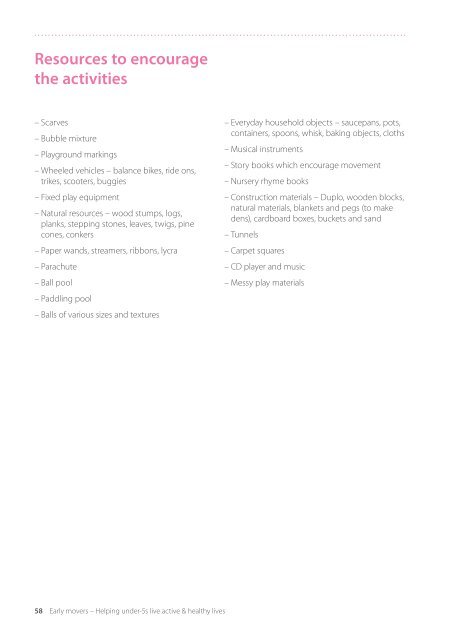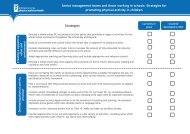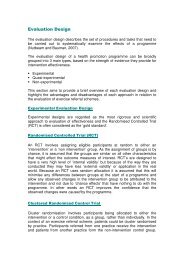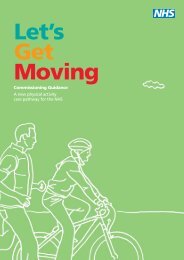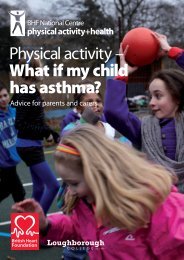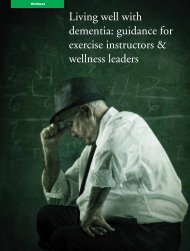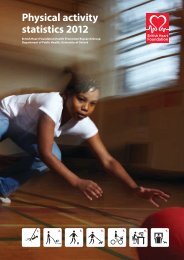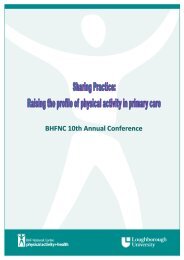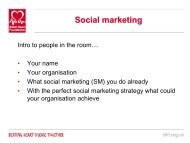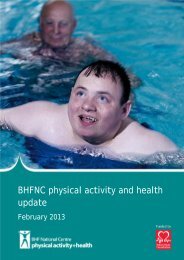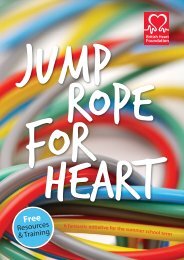5 Practical ideas for physically active play - BHF National Centre ...
5 Practical ideas for physically active play - BHF National Centre ...
5 Practical ideas for physically active play - BHF National Centre ...
- No tags were found...
Create successful ePaper yourself
Turn your PDF publications into a flip-book with our unique Google optimized e-Paper software.
Resources to encouragethe activitiesProgress in physicaldevelopment– Scarves– Bubble mixture– Playground markings– Wheeled vehicles – balance bikes, ride ons,trikes, scooters, buggies– Fixed <strong>play</strong> equipment– Natural resources – wood stumps, logs,planks, stepping stones, leaves, twigs, pinecones, conkers– Paper wands, streamers, ribbons, lycra– Parachute– Ball pool– Paddling pool– Balls of various sizes and textures– Everyday household objects – saucepans, pots,containers, spoons, whisk, baking objects, cloths– Musical instruments– Story books which encourage movement– Nursery rhyme books– Construction materials – Duplo, wooden blocks,natural materials, blankets and pegs (to makedens), cardboard boxes, buckets and sand– Tunnels– Carpet squares– CD <strong>play</strong>er and music– Messy <strong>play</strong> materialsMoving and handling activities that youngchildren of 1–3 years may be able to do are:8–20 months– Walk around furniture lifting one foot andstepping sideways (cruising), and walk withone or both hands held by an adult.– Take their first few steps independently.– Pass toys from one hand to another.– Hold an object in each hand and bring themtogether in the middle, eg, hold two blocksand bang them together.16–24 months– Walk upstairs holding your hand.– Come downstairs backwards on their knees(crawling).– Begin to balance blocks to build a small tower.22–36 months– Run safely on their whole foot.– Squat with steadiness to rest or <strong>play</strong> withobject on the ground, and rise to their feetusing their hands.– Climb confidently and begin to pull themselvesup on nursery <strong>play</strong> climbing equipment.– Kick a large ball.– Walk upstairs or downstairs holding onto a railtwo feet to a step.– Begin to use three fingers (tripod grip) to holdwriting tools.But children develop at their own rate, andin their own ways. This isn’t a definitive list ofdevelopment milestones, and isn’t intended asa checklist <strong>for</strong> you to assess the young childrenin your care.The above statements have been takenfrom Development Matters in the Early YearsFoundation Stage (EYFS). Not all statementsare included here. Download at:www.early-education.org.ukSimilar development markers are also availablein the Welsh guidance materials FoundationPhase Child Development Profile Guidance.Download at: www.wales.gov.uk For prompts <strong>for</strong> running, catching, hopping,throwing, striking and jumping, see skills cardson page 85–90.58 Early movers – Helping under-5s live <strong>active</strong> & healthy livesSection 5 – <strong>Practical</strong> <strong>ideas</strong> <strong>for</strong> <strong>physically</strong> <strong>active</strong> <strong>play</strong> 59


